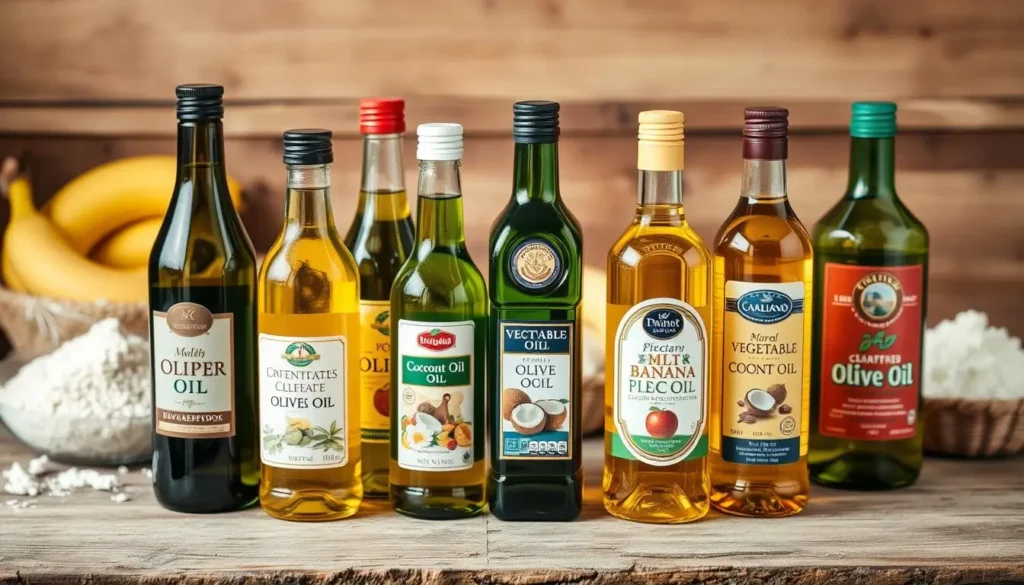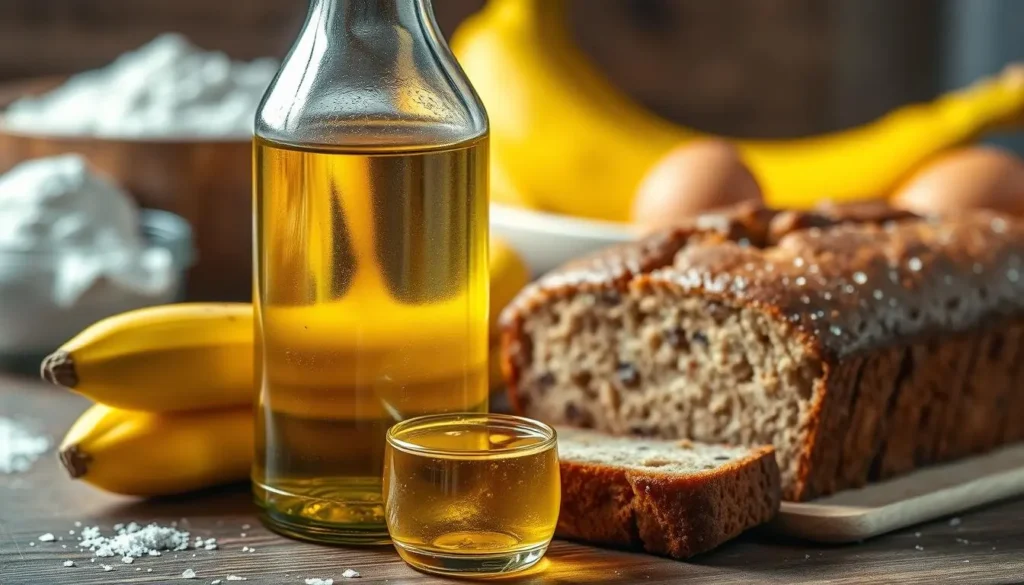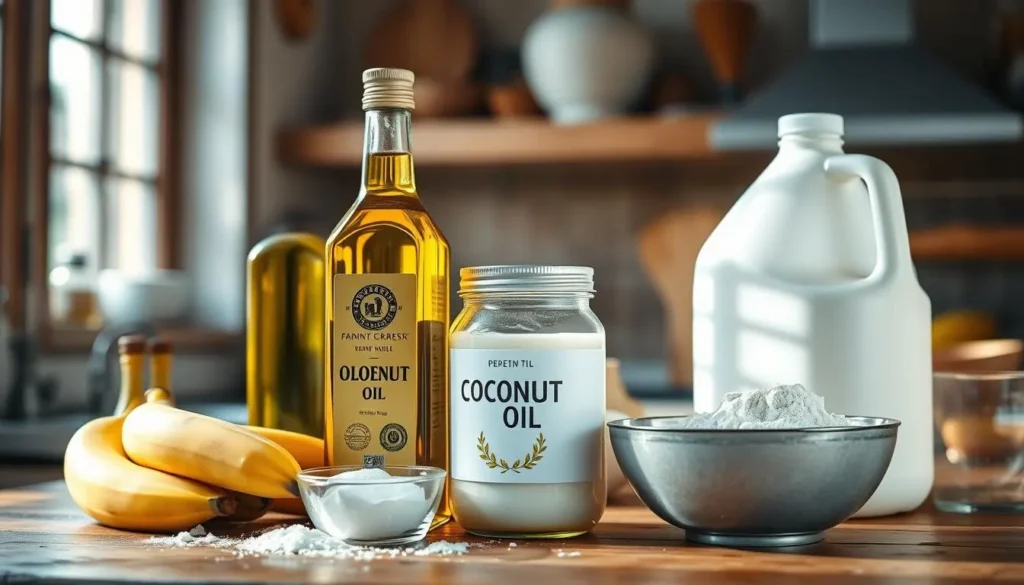When baking banana bread, you want it to be moist and full of flavor. The type of oil you use is key. So, what’s the best oil for banana bread? Choosing the right oil can greatly improve your banana bread.
The right oil can make your banana bread taste better and feel softer. Whether you’re an experienced baker or new to it, picking the best oil is crucial. With many oils to choose from, it can be hard to decide.
When picking an oil for banana bread, think about what matters to you. Consider the flavor, texture, and how moist it will be. The right oil can make your banana bread not only taste great but also look good. So, what should you look for in an oil for your banana bread recipe?
Key Takeaways
- Choosing the right oil is crucial for a moist and flavorful banana bread
- The best oil for banana bread can vary depending on personal preference and recipe requirements
- Understanding the characteristics of different oils can help you make an informed decision
- A good banana bread recipe starts with the right oil and ingredients
- Experimenting with different oils can help you find the perfect fit for your banana bread
- Considering factors like flavor, texture, and moisture content can help you select the best oil

The Role of Oil in Creating Perfect Banana Bread
Oil is key in making banana bread. It affects the bread’s texture and taste. Different oils change the bread’s moisture, texture, and crumb in unique ways.
The moisture in banana bread comes from the oil. Oils like canola or vegetable oil make the bread tender and moist. But oils like coconut oil can make the bread denser and drier. Knowing how oils change moisture is crucial for the perfect banana bread.
How Oil Affects Moisture Content
Oil’s effect on moisture depends on its type and properties. Oils with more polyunsaturated fats make the bread tender. Those with more saturated fats make it denser. Choosing the right oil helps control moisture and texture.
Impact on Texture and Crumb Structure
The texture and crumb of banana bread also depend on the oil. Avocado oil, with a high smoke point, makes the bread tender. Olive oil, with a lower smoke point, makes it denser. The right oil and amount create the perfect texture and crumb.
Best Oil Options for Your Banana Bread Recipe
Choosing the right oil for banana bread is important. It affects the taste, texture, and quality of your bread. You can pick from vegetable oil, canola oil, or coconut oil. Each has its own benefits.
Vegetable oil is a top pick because it tastes neutral and can handle high heat well. Canola oil is also great, with a light taste and high heat tolerance. Coconut oil is a healthier choice, packed with good fats and a distinct taste.
When picking oil for banana-bread, think about a few things:
- Flavor: Pick an oil that fits the taste you want. Vegetable or canola oil for a neutral taste, or coconut oil for something unique.
- Smoke point: Choose an oil that can handle baking’s high heat.
- Health benefits: Consider the oil’s health perks. Coconut oil, for example, is full of healthy fats.
In short, the best oil for banana bread depends on what you need. Think about flavor, heat tolerance, and health benefits. This way, you’ll get a delicious, moist banana bread.
| Oil Option | Flavor | Smoke Point | Health Benefits |
|---|---|---|---|
| Vegetable Oil | Neutral | High | None |
| Canola Oil | Light | High | None |
| Coconut Oil | Unique | Medium | High in healthy fats |
Understanding Smoke Points and Why They Matter
Choosing the right oil is key in baking. The smoke point of an oil is very important. It’s the temperature at which an oil starts to smoke and break down.
If you heat an oil too high, it can ruin the taste and texture of your baked goods. Knowing the smoke points of oils helps make your baked goods better.
When picking oils for baking, think about their smoke points. Avocado oil, for example, has a high smoke point, perfect for high-heat baking. Olive oil, with a lower smoke point, is better for low-heat baking or as a finishing touch. Knowing these smoke points helps you choose the right oil for your baking.
Different Oil Smoke Points
Here are some common oils and their smoke points:
- Avocado oil: 520°F (271°C)
- Canola oil: 468°F (242°C)
- Coconut oil: 350°F (177°C)
- Olive oil: 320°F (160°C)
These smoke points are crucial for your baking. Choose an oil that matches the baking temperature for the best results.
How Smoke Points Affect Baking
Smoke points can change the texture and taste of your baked goods. Using a low smoke point oil can damage it and ruin the flavor. But, a high smoke point oil can make your baked goods lighter and flakier.
By understanding oil smoke points, you can pick the best oil for your baking. This ensures your baked goods turn out the best they can.
What Is the Best Oil to Use When Making Banana Bread
Choosing the right oil for banana-bread is important. It can make your bread taste better and feel softer. You want an oil that makes your banana-bread moist and tasty.
Vegetable oil, canola oil, and coconut oil are good choices. Vegetable oil doesn’t change the taste much but is good for baking. Canola oil has a light taste and is safe for baking. Coconut oil adds a special flavor and is great for a unique taste.
Benefits of Different Oils
- Vegetable oil: neutral flavor, high smoke point
- Canola oil: mild flavor, low smoke point
- Coconut oil: distinct flavor, high smoke point
What’s the best oil for banana bread? It depends on what you like. If you prefer a simple taste, choose vegetable or canola oil. For something special, coconut oil is perfect. Pick the oil that matches your banana bread goals.
Using the right oil makes your banana bread delicious and moist. It’s great for eating or sharing with others. Whether you pick vegetable, canola, or coconut oil, use it wisely. Mix it with other ingredients for the best taste and texture.
| Oil Type | Flavor | Smoke Point |
|---|---|---|
| Vegetable Oil | Neutral | High |
| Canola Oil | Mild | Low |
| Coconut Oil | Distinct | High |
Measuring Bananas: Getting the Ratio Right
When making banana bread, measuring bananas is key to a perfect loaf. The right banana ratio affects the bread’s texture and taste. To measure bananas correctly, you need to know how.
For every loaf, use 3-4 ripe bananas. But, banana sizes differ, so measuring in cups or grams is best. Aim for 1 1/2 to 1 3/4 cups of mashed bananas per loaf.
- Use a digital scale to measure the bananas in grams.
- Mash the bananas and measure them in cups.
- Choose bananas that are ripe but still firm, as they will be easier to mash and measure.
By following these tips and using the right banana ratio, you’ll make a delicious banana bread. Remember, measuring bananas is a crucial step, so don’t skip it!

Oil Substitutions in Banana Bread
Oil is key in banana bread for moisture and flavor. You can try different oils to change the taste and texture. Butter alternatives, for example, can make the bread richer and creamier.
Applesauce is another good choice. It cuts down on oil and adds sweetness and moisture. Greek yogurt also works well, bringing a tangy taste and softness to the bread.
Butter Alternatives
Coconut oil or avocado oil can replace regular oil. They give the bread a special flavor. This makes your banana bread stand out.
Applesauce and Other Fruit Purées
Applesauce is a smart oil substitute. But you can also try mashed bananas or pumpkin puree. They add sweetness and moisture, reducing oil needs.
Greek Yogurt Options
Greek yogurt adds a tangy taste and softness. You can mix it with honey or vanilla for a unique flavor.
Trying different oils can make your banana bread special. Whether it’s butter alternatives, applesauce, or greek yogurt, the goal is to find the perfect mix. This will give you the best flavor and texture.
Common Oil-Related Mistakes in Banana Bread Making
When making banana bread, you want it to be moist and tasty. But, common mistakes can happen, especially with oil. Using the wrong oil can change how your bread tastes and feels.
To avoid these mistakes, it’s key to know how oil works in banana bread. Here are some tips to remember:
- Choose the right type of oil: Pick an oil with a high smoke point, like canola or vegetable oil. This prevents your bread from tasting bitter.
- Use the correct amount: Too much oil makes your bread greasy, while too little makes it dry. Find the right balance for a moist and tasty loaf.
- Avoid overmixing: Mix your ingredients just until they’re combined. Overmixing can make your bread dense and tough.
By following these tips and watching out for common mistakes, you can make a delicious banana bread. Always use high-quality ingredients and be careful with oil-related mistakes to keep your bread moist and flavorful.
With practice and patience, you’ll get better at making banana bread and avoiding common mistakes. So, go ahead, start baking, and enjoy your hard work!
| Oil Type | Smoke Point | Suitability for Banana Bread |
|---|---|---|
| Canola Oil | 468°F | Excellent |
| Vegetable Oil | 400°F | Good |
| Coconut Oil | 350°F | Fair |
Tips for Storage and Maintaining Moisture
To keep your banana bread fresh, follow some key storage tips. Store it in an airtight container to keep air out. This helps maintain moisture and keeps the bread fresh longer.
Use plastic wrap or aluminum foil to wrap the bread tightly. Store it at room temperature. You can also freeze it for up to three months. To eat it, thaw at room temperature or reheat using different methods.
Proper Storage Techniques
Storing banana bread right is key to keeping it fresh. Store it in a cool, dry place, away from sunlight. This prevents mold and bacteria, which can spoil the bread.
Reheating Methods
There are many ways to reheat banana bread. You can use the microwave, oven, or toaster. Wrap the bread in a damp paper towel and heat for a few seconds in the microwave or a few minutes in the oven. This brings back the bread’s moisture and flavor.
By using these storage and reheating tips, you can enjoy banana bread longer. Always check for spoilage before eating. Proper storage helps prevent waste.

Conclusion: Creating Your Perfect Loaf
Now that you know how oil affects banana bread, you can make your own delicious loaf. Choose the best oil for your recipe, thinking about its smoke point and taste. By getting the oil-to-banana ratio right and avoiding mistakes, you’ll bake a perfect loaf of banana bread recipe every time.
Enjoy the baking process and feel free to try new things. This way, you’ll create a banana bread that everyone will love. Your family and friends will be impressed by your baking skills.
FAQ
How many bananas do I need for a banana bread recipe?
A typical banana bread recipe needs 2 to 3 ripe bananas. This is about 1 cup of mashed banana.
What can I use if I don’t have enough bananas for my banana bread recipe?
If you’re short on bananas, try using applesauce or mashed pumpkin. Make sure to use the same amount as the recipe calls for.
What is the number one mistake people make when baking banana bread?
The biggest mistake is overmixing the batter. This makes the bread tough and dense. Mix the ingredients just until they’re combined, and don’t over-stir.
How do I measure the bananas for a banana bread recipe?
When a recipe asks for bananas, measure the mashed banana by volume. 1 cup of mashed banana is usually 2-3 ripe bananas.
Can I substitute the oil in a banana bread recipe?
Yes, you can swap the oil for melted butter, applesauce, or Greek yogurt. The texture and taste might change a bit.

